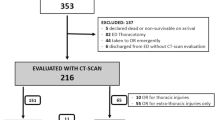Abstract
Objective
To highlight the significance and imaging characteristics of Morel-Lavallée (ML) lesions, which have been well characterized on MRI, but are potentially under-recognized on CT.
Materials and methods
Twenty-eight Morel-Lavallée lesions were identified in 18 patients and were all clinically or surgically confirmed. Lesions were grouped into acute (<3 days), subacute (3–30 days), and chronic (>30 days) at the time of CT imaging. Charts were reviewed to gather patient characteristics, injury patterns, radiologist interpretation, treatment, and outcomes.
Results
Sixteen male and 2 female patients with a mean age of 50 years (range 19–80) at the date of their initial evaluation were identified. All patients had significant trauma that accounted for 28 ML lesions, all of which were in a characteristic subcutaneous location overlying the muscular fascial plane. Lesions on CT went through an evolution from hyperdense, poorly or moderately marginated without a pseudocapsule to being hypodense, with internal fat globules or septations and well marginated with a complete enhancing pseudocapsule. Only 1 (4 %) of the ML lesions was suggested and 7 (25 %) lesions were not commented on at all by the interpreting radiologist.
Conclusion
Morel-Lavallée lesions are post-traumatic closed, internal, soft-tissue, degloving lesions that are potentially underrecognized on CT. Most acute ML lesions are nonspecific, resembling simple hematomas or contusions. ML lesions evolve as they age with subacute and chronic lesions demonstrating the known features described on MR imaging that should allow for an accurate imaging diagnosis.




Similar content being viewed by others
References
Morel-Lavallée M. Epanchements traumatique de serosite. Arch Gen Med. 1853;31:691–731.
Hudson DA, Knottenbelt JD, Krige JE. Closed degloving injuries: results following conservative surgery. Plast Reconstr Surg. 1992;89(5):853–5.
Hak DJ, Olson SA, Matta JM. Diagnosis and management of closed internal degloving injuries associated with pelvic and acetabular fractures: the Morel-Lavallee lesion. J Trauma. 1997;42(6):1046–51.
Kottmeier SA, Wilson SC, Born CT, Hanks GA, Iannacone WM, DeLong WG. Surgical management of soft tissue lesions associated with pelvic ring injury. Clin Orthop Relat Res. 1996;329:46–53.
Letts RM. Degloving injuries in children. J Pediatr Orthop. 1986;6(2):193–7.
Nickerson TP, Zielinski MD, Jenkins DH, Schiller HJ. The Mayo Clinic experience with Morel-Lavallee lesions: establishment of a practice management guideline. J Trauma Acute Care Surg. 2014;76(2):493–7.
Cormack GC, Lamberty BG. The blood supply of thigh skin. Plast Reconstr Surg. 1985;75(3):342–54.
Lovern RE, Bosse DA, Hartshorne MF, Bauman JM, Billingsley JL, Byrd BF, et al. Organizing hematoma of the thigh. Multiple imaging techniques. Clin Nucl Med. 1987;12(8):661–4.
Mellado JM, Bencardino JT. Morel-Lavallee lesion: review with emphasis on MR imaging. Magn Reson Imaging Clin N Am. 2005;13(4):775–82.
Mellado JM, Perez del Palomar L, Diaz L, Ramos A, Sauri A. Long-standing Morel-Lavallee lesions of the trochanteric region and proximal thigh: MRI features in five patients. AJR Am J Roentgenol. 2004;182(5):1289–94.
Bonilla-Yoon I, Masih S, Patel DB, White EA, Levine BD, Chow K, et al. The Morel-Lavallee lesion: pathophysiology, clinical presentation, imaging features, and treatment options. Emerg Radiol. 2014;21(1):35–43.
Neal C, Jacobson JA, Brandon C, Kalume-Brigido M, Morag Y, Girish G. Sonography of Morel-Lavallee lesions. J Ultrasound Med. 2008;27(7):1077–81.
Nakano M, Kondoh T, Igarashi J, Kadowaki A, Arai E. A case of chronic expanding hematoma in the tensor fascia lata. Dermatol Online J. 2001;7(2):6.
Parra JA, Fernandez MA, Encinas B, Rico M. Morel-Lavallee effusions in the thigh. Skeletal Radiol. 1997;26(4):239–41.
Gilbert BC, Bui-Mansfield LT, Dejong S. MRI of a Morel-Lavellee lesion. AJR Am J Roentgenol. 2004;182(5):1347–8.
Reddix Jr RN, Carroll E, Webb LX. Early diagnosis of a Morel-Lavallee lesion using three-dimensional computed tomography reconstructions: a case report. J Trauma. 2009;67(2):E57–9.
Author information
Authors and Affiliations
Corresponding author
Ethics declarations
Conflicts of interest
The authors declare that they have no conflicts of interest.
Rights and permissions
About this article
Cite this article
McKenzie, G.A., Niederhauser, B.D., Collins, M.S. et al. CT characteristics of Morel-Lavallée lesions: an under-recognized but significant finding in acute trauma imaging. Skeletal Radiol 45, 1053–1060 (2016). https://doi.org/10.1007/s00256-016-2374-y
Received:
Revised:
Accepted:
Published:
Issue Date:
DOI: https://doi.org/10.1007/s00256-016-2374-y




